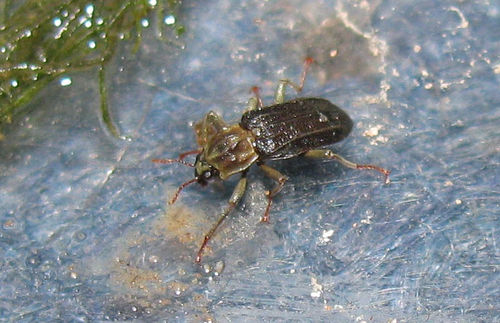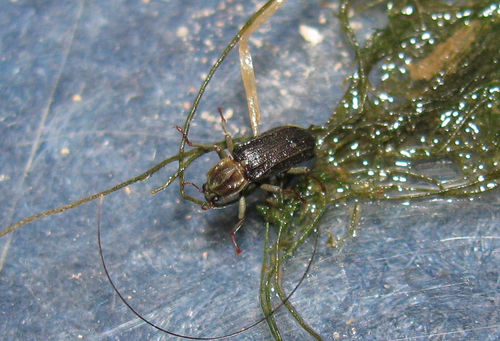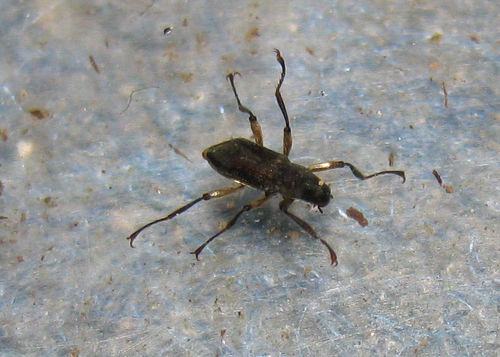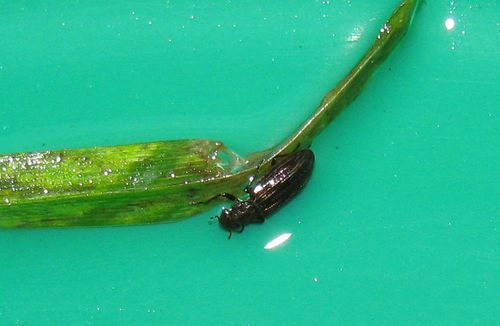Stenelmis canaliculata (Gyllenhal, 1808) (Col., Elmidae) and other aquatic Coleoptera from the Kidderminster and Bewdley areas of Worcestershire
Alan Brown.
On the 24 August, 2014 a single specimen of our largest Riffle Beetle Stenelmis canaliculata was found on a sandbank alongside the River Severn at Bewdley (01 & 02). This is the first Worcestershire record and its identity was confirmed by Paul Whitehead. The current national status is RDB2.
Description: About 5mm long, sculptured on the elytra with four prominent ridges, two of which extend the full length of the elytra, the two inner ridges extending to about halfway down. The pronotum is square with a visible channel down the centre. The tips of the tarsi and apical segments of antennae are red.
Distribution: Recorded from 12 rivers in the last 20 years. First discovered at Lake Windemere in Cumbria, this species has a scattered distribution mainly in fast-flowing rivers in Herefordshire, Devon, Cornwall, Nottinghamshire and Bedfordshire. There is a 1996 record apparently from the Kennet and Avon Canal near Bath North Somerset and a more recent one from the River Findhorn at Moray, Scotland.
History: This species was not added to the British list until 1960 when it was found on a wave-washed shingle bank on Lake Windermere. Since then, records have predominantly come from clean, fast-flowing streams and rivers with gravelly or stony bottoms. Like some other species of elmid it needs well-oxygenated water free of pollution making it a very good indicator of water purity. The beetle itself extracts oxygen from the water and does not need to surface except for a brief period of flight shortly after emergence from its pupa. It is thought to feed on algae attached to stones and prefers deep water.
Notes: Not much is known about this beetle’s life cycle. I found the beetle, in this case an adult female, on sandy ground close to the water’s edge at night. At the time I was looking for ground beetles so I was quite surprised to find it there. It was on a cold autumn evening and the beetle seemed to be moving away from the water. I have seen other elmids above water level so perhaps this was not such an unusual event. With my headband torch I had no difficulty in picking it out despite its small size.
Other Notable Finds
Macronychus quadrituberculatus Müller, 1806. Elmidae: Nationally rare. River Severn, Bewdley, 10 August 2014. The River Severn is a well-known stronghold for this species and I saw them on most of the pieces of decaying wood in shallow water and also occasionally on sandbanks close to the water's edge. They are quite colourful and unusual with long legs (03).
Pomatinus substriatus (Müller, 1806). Elmidae: Nationally rare. Kidderminster 22 April 2014. Ironically, I recorded this species not in the River Severn, but in the Kidderminster to Cookley section of the Staffordshire and Worcestershire Canal running alongside Springfield Park. It was spotted at night apparently feeding on algae growing on the canal's concrete wall about two inches below the water surface. Three other beetles from bare mud alongside a stream running through the park were identified as the dryopids Dryops ernesti des Gozis, 1886 by Paul Whitehead.
Hydrochus elongatus (Schaller, 1783). Hydrophilidae: Nationally scarce. Kidderminster 23 April 2014. A Water Scavenger Beetle found in good numbers in a shaded willow carr bog pool at Springfield Park. The pool itself is a seasonal one tending to dry up in the summertime, but for the last two years has remained full. The pool contains decaying leaves and wood with some mosses. The beetle was easily found at night walking underneath the surface tension of the water and could be scooped up without using a net (04).
Helophorus dorsalis (Marsham, 1802). Hydrophilidae: Nationally scarce Kidderminster 22 April 2010. A Water Scavenger Beetle found during my Ground Beetle survey. This species was found in the same shaded willow carr bog pool at Springfield Park as Hydrochus elongatus and found in the same way. Good numbers were found at night on the water surface.
Acknowledgements
Unfortunately, the 2014 season was to be my last recording for the Worcestershire Biological Records Centre in Worcestershire as I moved elsewhere at the end of the year. It was a memorable six years. Within a two mile radius of Kidderminster, some 101 nationally scarce species of Coleoptera were found together with nine RDB species. There are undoubtedly many more there still to be found. I would like to thank John Meiklejohn, Paul Whitehead, Harry Green, Simon Wood and Rosemary Winnall for the help they gave me during this survey. I am grateful to Paul Whitehead for his constructive assistance in the preparation of this short paper; any factual errors are mine alone. Good luck to everyone for 2015.
Images
01. Stenelmis canaliculata River Severn, Bewdley, 10 August 2014. Alan Brown
02. Stenelmis canaliculata River Severn, Bewdley, 10 August 2014. Alan Brown
03. Macronychus quadrituberculatus River Severn, Bewdley, 10 July 2014. Alan Brown
04. Hydrochus elongates Kidderminster 22 April 2014. Alan Brown



